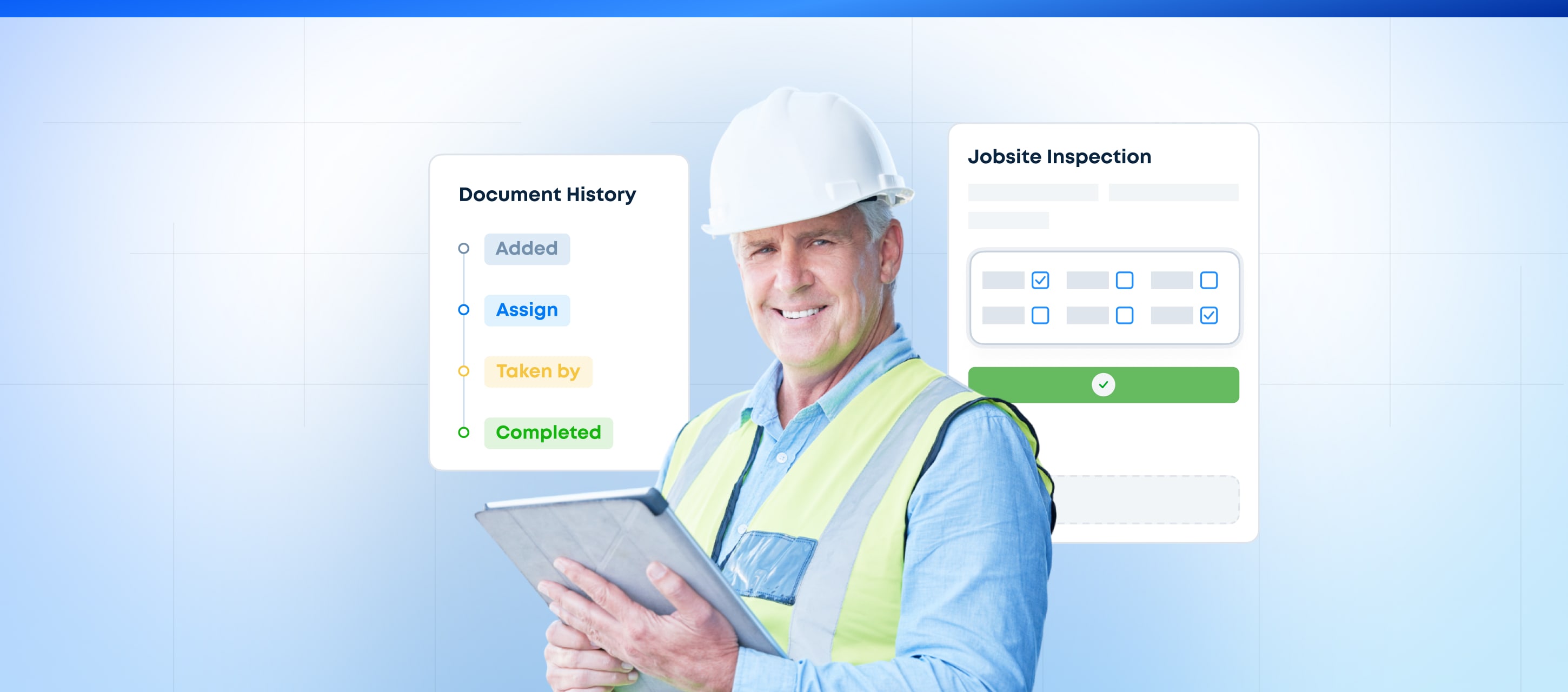Imagine a construction site where everything goes according to plan: projects stay on schedule, costs don’t go over budget, and problems are quickly resolved. This isn’t just wishful thinking, it’s what digital transformation makes possible.
This guide will walk you through how digital tools can transform construction processes and give you full control over your projects, whether just starting or fine-tuning your digital approach.
Contents:
What Is Digital Transformation in Construction?
Digital transformation in construction means using technologies to improve every part of the construction process.
It includes adopting technologies like Building Information Modeling (BIM), drones, and Computer-Aided Design (CAD). It’s also about tweaking processes to make workflows easier, improve project management, and help teams work better together.
But, for all this to work, it’s important that all team members feel comfortable using new tools and are open to change. When the whole team is on board, that’s when digital transformation can make a difference.
Why Is Construction Digital Transformation Important?
Did you know that U.S. construction productivity has dropped 40% since 1970? But that’s not all. Just ask any construction HR rep, and they’ll tell you how tough it is to find skilled workers. And with projects getting more complex, it’s harder to get them off the ground.
The good news is that digital technologies can help you manage these challenges. They won’t solve every problem, but they’re a reliable way to stay competitive in the market.
Work Smarter, Not Harder
See how Fluix can help your team achieve more with less effort
Benefits of Digital Transformation for the Construction Industry
Even with all its challenges, the construction industry has been slow to adopt new technologies. Maybe it’s because people are attached to the old ways of doing things, or they’re just unaware of the benefits. But this hesitation is causing companies to miss out on chances to grow and improve.
Here’s why it might be time for you to give construction digital transformation a second look:
1. Increased Productivity
Digital tools can make your work processes smoother and more productive. For example, workflow software can automate routine tasks, like processing approvals and managing submittals. This means less admin work and more time for the tasks that truly matter.
2. Improved Site Safety
Advanced technologies can boost your site safety by spotting hazards in real-time, reducing the chances of injuries. For instance, wearable sensors can warn workers about dangers like unstable surfaces or falling objects. This helps prevent accidents before they happen.
3. Strengthened Communication and Collaboration
Switching from paper to a digital system can make it easier for your construction teams to work together.
With document management platforms, architects, site managers, and engineers can submit and review project documents from anywhere. Many of these platforms will let your team share site photo documentation too, helping everyone stay on the same page and track progress.
4. Streamlined Construction Labor
Robots and automation are now doing tasks that humans used to do, which helps with the labor shortage in construction. For example, rebar-tying robots can work with just one person overseeing them.
Robots are also taking on high-risk tasks, like handling hazardous materials, to make construction sites safer.
5. Better Decision-Making
Data management software helps you gather information during the construction process. By analyzing this data, you can see what’s going well and what needs improvement.
With project management in construction, checking past data can help you predict delays or extra costs ahead of time. This lets your team make good decisions and stay ahead of potential issues.
Using Digital Tools Across the Construction Lifecycle
Digital transformation can help every stage of your construction projects run smoothly.
Planning
Digital tools make planning easier by improving project management, scheduling, and resource allocation.
- Technology Example: Project Management Information Systems (PMIS)
- How It Works: PMIS brings all project management tasks into one platform. It includes tools like Gantt charts for scheduling, resource histograms, and cost-control features to keep your budget on track.
- Benefits: It helps you stay organized, use resources efficiently, and keep costs and timelines under control.
Design
In the design phase, you can use digital tools to develop detailed architectural and engineering plans for buildings and structures.
- Technology Example: Computer-Aided Design (CAD)
- How It Works: CAD lets you create 2D or 3D models of buildings. It’s simple to make adjustments to these models and to share them with others.
- Benefits: It increases accuracy and improves communication between architects, engineers, and clients.
Execution
Digital construction management improves the execution process by making on-site operations smoother and keeping projects on track.
- Technology Example: Construction Management Software
- How It Works: This software tracks construction progress in real time, automates tasks, and makes it easy for teams to share information.
- Benefits: It boosts efficiency, improves teamwork, and ensures quality control throughout the construction process.
Learn More Learn More 15 best construction management tools for 2026
Maintenance
In the maintenance phase, digital solutions help you manage and maintain completed buildings, keeping them in top shape.
- Technology Example: Internet of Things (IoT) Sensors
- How It Works: IoT sensors in buildings monitor things like temperature, humidity, and structural health. They provide real-time data and send alerts if there’s a problem.
- Benefits: They improve preventative maintenance, cut down on downtime, and extend the life of buildings.
Digital tools really help with construction process management. They keep each phase – from planning to maintenance – on track.
Challenges of Digital Transformation in Construction
Digital transformation in construction brings plenty of benefits, but there are a few challenges to consider.
| Challenge | Consideration | Solution |
|---|---|---|
| Cost | Digital technology in construction can be costly upfront. | Pick tools that save you money in the long run and deliver a strong return on investment. |
| Integration Incompatibility | There are many software tools, and getting them to work together can be complex. | Choose tools that work smoothly with what you already use so collaboration between construction teams is seamless. |
| Cybersecurity Risks | The more digital tools you use, the higher the risk of cyber attacks. | Keep your systems safe with strong security measures and train your team to follow them. |
| Resistance to Change | Your team might be hesitant to use new tools. | Try low/no-code software to make the switch easier, and ensure platforms are user-friendly for all generations. |
| Unique Projects | Every construction project is different, so standard digital tools might not always work. | Find digital tools that offer customizable solutions tailored to your projects. |
Construction Digital Transformation: A Case Study
At Leach Wallace Associates (LWA), paper-based processes were causing all sorts of frustrating delays. Field engineers spent way too much time sifting through bulky binders just to find the right forms. On top of that, their workflow, approval, and communication processes struggled to keep pace, eating up time and draining team resources.
LWA turned to Fluix construction field software to put an end to these inefficiencies. With Fluix, they now prepare field tasks in the office and send them straight to engineers’ iPads as automated checklists. Engineers in the field submit all their data and reports digitally, right from their devices.
This digital shift has sped up tasks and made data easy to access. Plus, sharing documents in real time has made it easier for field and office teams to stay in sync and keep projects on track.
You can find their full story here.
How to Start Transforming Your Construction Business
Transforming your construction business might feel overwhelming, but it doesn’t have to be. Here’s how you can start, one step at a time.
Step 1: Assess Current Processes and Pain Points
First, get a clear picture of how things are running and figure out where you need to improve. Here are some approaches to get you going:
- Analyze Your Workflows: Take a close look at how your operations work. Map out your workflows to see how tasks are done. Spot pain points like delays, high costs, poor communication, or safety issues.
- Compare With Industry Standards: Check how your processes stack up against industry best practices. This will help you find gaps and areas where you can do better.
- Gather Feedback: Talk to your teams, contractors, and other stakeholders. Their insights could reveal problems you might not have noticed.
Step 2: Define Clear Goals and Objectives
Now that you’ve got a handle on your current situation, it’s time to decide what you want to achieve with your digital transformation. Here’s how:
- Set Your Goals: Figure out what success looks like for you. Maybe you want to improve construction labor productivity by 20% or improve on-site safety.
- Determine Resource Requirements: Identify the resources you’ll need—whether it’s money, people, or technology—to make it happen.
- Outline Measurable Targets: Set a timeline with specific, measurable milestones to track your progress and stay on course.
Step 3: Evaluate Your Digital Readiness
Before diving into new technologies, it’s important to assess how ready your organization is. This helps ensure a smooth transition. Here’s what to do:
- Evaluate Existing Technology: Review the tools and systems you’re currently using. Are they up-to-date? Can they handle the new digital solutions you’re hoping to implement?
- Check Digital Skills: See how comfortable your team is with technology. Identify any areas where they might need additional training to catch up.
- Assess Data Management Capabilities: Make sure your organization is set up to handle construction project data effectively. You’ll need strong systems for collecting, analyzing, and storing data to assess whether your digital transformation is successful.
Step 4: Choose Your Tools
Once you’ve checked your digital readiness, it’s time to pick the tools that will help you reach your goals. Here are some general points to consider:
- Ease of Use: Are the tools user-friendly?
- Compatibility: Will these tools work smoothly with your current systems and other tools you’re already using?
- Reliable Support: Is customer support available to help you with any questions or issues?
- Scalability: Can the tools grow with your business and continue meeting your needs as you expand?
- Assessment Opportunities: Are there free trials available so you can test the tools in your environment and make sure they’re the right fit?
Learn More Learn More Explore the top 5 daily report software solutions every site manager should know about.
Step 5: Secure Team Endorsement
To make your digital transformation a success, you need everyone’s support—employees, contractors, and clients. Here’s how to bring them on board:
- Communicate Benefits: Clearly explain how the digital tools will make their jobs easier. Address any concerns they have and show them the positive impact these changes will have on their work.
- Offer Training and Support: Provide training sessions and resources to help your team get comfortable with the new technologies. Ongoing support and education will make the transition smoother and help everyone feel confident using the tools.
Step 6: Implement Your Technology Solutions
When it’s time to roll out your new digital tools, you’ll want to keep these tips in mind:
- Start Small: Test the tools with a pilot project before going all in. This lets you catch any issues early and make adjustments on a smaller scale, reducing risks.
- Track Success: Monitor key metrics to see if you’re hitting your goals. Regularly review these numbers to stay on track and make smart decisions.
- Celebrate Wins: Highlight and share early successes to boost morale and show everyone the real benefits of the tools.
- Stay Flexible: Be ready to adjust based on feedback and results. Keep refining your approach to improve your digitalization and address any challenges.
Digital transformation can make a big difference in construction, but it needs the right tools to be effective. That’s where Fluix comes in. Fluix is construction management software that’s simple for field workers to use—no tech skills required.
Here’s how Fluix makes your job easier:
- Go digital with forms and approvals: Cut down on admin work and ensure all team members have the latest information.
- Streamline task management: Automate routine tasks like daily reports, inspections, and compliance checks, freeing up more of your time.
- Improve safety: Track inspections and analyze data to keep your team safe and on point.
- Stay on top of everything: Keep a clear record of all activities, making it easy to monitor progress and fix issues fast.
- Adapt on the fly: Quickly adjust workflows as projects change, so you’re always ready for what’s next.
Give your teams the tools they need to work smarter, safer, and more efficiently. Make every project successful with Fluix’s streamlined solutions.






